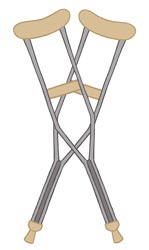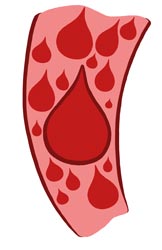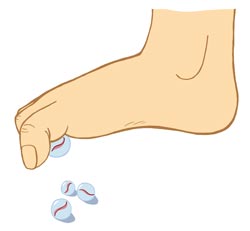There is so much misinformation that is on the internet and how to treat plantar fasciitis, this post is going to outline the ONLY things that should be done to help heal your plantar fasciitis. After reading up on all of the treatment modalities out there, there are many many things out there that will hurt you and cause further damage.
Follow along and become plantar fasciitis free in no time!
SEVEN THINGS TO HEAL PLANTAR FASCIITIS OR YOUR MONEY BACK!
Once there has been an injury, resting your foot and realizing that you’re injured is the first step to a speedy recovery. Rest will allow your body to do what it has to do in order to start the healing process.
Crutches
Crutches are the most important part that everyone forgets about. Use crutches until the pain goes away. Why? If you fracture or injure a bone, the doctor recommends crutches and says to stay off your feet for four to six weeks until the injury has finished healing itself. Why wouldn’t you do the same thing to your plantar fascia? The ligament is inflamed and possibly torn, why wouldn’t you stay off your foot until the ligament has a chance to heal fully?
Cold Compression
Cold compression on the foot will not only help reduce pain, but will help reduce inflammation. Cold compression instead of icing the plantar fascia will help reduce the inflammation quicker than just ice.
Optimal Blood Flow
To achieve optimal blood flow–inflammation whether internal or external–needs to be alleviated first. Once inflammation has been targeted, light exercises will help increase blood flow, as will heat such as heating pads or hot baths. Devices are also available to target optimal blood flow without having to move the injured area, increasing healing time as there is less chance of re-injury if there is no movement.
Proper Shoes
Wearing proper shoes that have the proper support is very important. The arch of the foot is naturally designed to support itself. When a step is taken, the weight is dispersed evenly on the balls of the feet and the heel. No weight is placed on the arch of the foot, so therefore no support is needed at the arch of the foot. Having cushioning on the heel and the balls of the feet are the only support needed, ensuring that the shoes fit properly and aren’t to tight.
Wearing slippers around the house will give some added support and cushioning from the hard floors. Although we recommend staying off your feet completely, if it is not possible, then relieving the impact each step takes will help alleviate some unnecessary pain.
Exercise
Providing there is no pain, work on exercises that don’t focus on the plantar fascia, but the muscles surrounding it. Strengthening the muscles around the injury will help prevent the injury from re-occurring. Pain is a sign that injury is happening, so make sure that with these exercises you’re not further damaging anything.
Physical Therapy
Physical therapy is a great way to get started with learning how to exercise the surrounding muscles and help heal yourself. Always keep in mind that you’re physical therapist doesn’t know if you’re in pain unless you say so. Don’t let him or her hurt you further. Only you know your body. Physical therapy uses exercises to help stimulate increased blood flow to the affected area.
Pain Pills
Pain pills should never be used to help you get through the day. You need to listen to your body and use the pain as a guideline of what you can and cannot handle. Once your day is finished or winding down–to help you relax–pain pills can be used. This will ensure that you’re not making the problem worse because you can’t feel the pain.
As long as you follow these guidelines, you should be back on your feet in no time. Don’t let plantar fasciitis become a chronic problem! Get better today!





